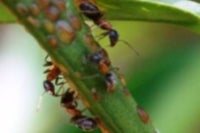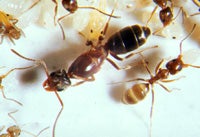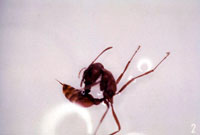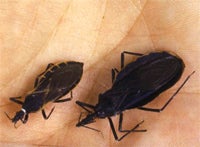Recent Research
Below is a list of some relatively recent research documentation. Feel free to browse the information presented and to contact us if you have any additional questions.
Ants
Approximately 270 species of ants are found in California. At least 25 different species are regularly collected in urban settings, several species being significant pests. Invasive species such as the red imported fire ant and rover ant have recently invaded the state.
- 2014 Hoey-Chamberlain and Rust. Food and Bait Preferences of Liometopum occidentale
- 2013 Hoey-Chamberlain et al. A Review of the Biology, Ecology and Behavior of Velvety Tree Ants of North America
- 2007 Kabashima et al. Aggression Between Fire Ants and Argentine Ants
- 2006 Greenberg et al. Metaflumizone Trials in CA
- 2005 Costa et al. Response to Permethrin Treated Plastic Strips
- 2003 Greenberg et al. Fipronil Trials
- 2003 Greenberg and Klotz. Fire Ant Fact Sheet
- 2001 Greenberg et al. Fire Ant Pest Note
- 1999 Greenberg et al. Fire Ants in CA
Argentine Ant
An exotic species first reported in California in the early 1900s. Currently, it is the number one household pest in California, and also a pest in agriculture and natural environments.
- 2013 Greenberg et al. Control of Argentine Ants in Citrus using Methoprene and Imidacloprid Delivered in Liquid Bait Stations
- 2012 Jiang et al. Runoff of Pyrethroid Insecticides from Concrete Surfaces Following Simulated and Natural Rainfalls
- 2010 Klotz et al. Developing Low Risk Management Strategies for Argentine Ants
- 2010 Choe et al. Development of Virtual Bait Stations to Control Argentine Ants in Environmentally Sensitive Habitats
- 2010 Greenberg et al. Impact of Ant Control Technologies on Insecticide Runoff and Efficacy
- 2009 Choe et al. Chemical Signals Associated with Life Inhibit Necrophoresis in Argentine Ants
- 2009 Klotz et al. Low Impact Directed Sprays and Liquid Baits to Control Argentine Ants
- 2008 Choe and Rust. Horizontal Transfer of Insecticides in Laboratory Colonies of the Argentine Ant
- 2008 Klotz et al. Controlling Argentine Ants in Residential Settings
- 2008 Rust et al. Testing Baits to Control Argentine Ants in Vineyards
- 2007 Klotz et al. An Evaluation of Several Urban Pest Management
- 2007 Field et al. On Target
- 2007 Field et al. A Survey of Structural Ant Pests in the Southwestern USA
- 2006 Choe and Rust. Homopteran Chemical Signatures Reduce Ant Agression
- 2006 Choe and Rust. Agonistic Behavior of Argentine Ants to Scales
- 2004 Soeprono and Rust. Effect of Ho¬rizontal Tranfer of Barrier Insecticides
- 2004 Klotz et al. Why Delay When You Bait and Spray
- 2004 Klotz et al. In Search of the SweetSpot
- 2002 Klotz et. al. Assimilation and Toxicity of Boron in the Argentine Ant
- 2000 Klotz et al. Toxicity and Repellency of Borate-Sucrose
- 2000 Greenberg and Klotz. Argentine ant trail pheromone
Cockroaches
Cockroaches are an important pest problem in structures wherever food is being prepared, stored or served. The German cockroach shown here with egg case is the most frequently encountered species in California and worldwide.
- 1996 Rust et al. The Feasibility of Using Nodified Atmospheres to Control Insect Pests in Museums
- 1993 Rust et al. Relationship Between Insecticide Resistance and Performance
- 1991 Rust et al. Control of American Cockroaches in Sewers
Fleas
Fleas are not only the most important pest of domesticated cats and dogs worldwide, but also attack calves, sheep, and horses, and have been implicated in the transmission of plague, murine typhus, and human spotted fever.
- 2013 Rust et al. Monitoring Field Susceptibility to Imidacloprid in the Cat Flea: A World-First Initiative Twelve Years On
- 2011 Rust et al. Large-Scale Monitoring of Imidacloprid Susceptibility in the Cat Flea, Ctenocephalides Felis
- 2006 Rust et al. New Methods and Strategies for Monitoring Susceptibility of Fleas to Current Flea Control Products
- 2005. Rust et al. Determining a Diagnostic Dose for Imidacloprid Testing of Cat Fleas
- 2003. Rust et al. Efficacy and Longevity of Nitenpyram Against Adult Cat Fleas
Spiders
Most spiders produce venom that is poisonous to their prey, usually insects and other small arthropods; the venom of these spiders is harmless to humans. A few such as black widows and recluse spiders produce venom that is toxic to humans.
- 2012 Vetter et al. The Prevalence of Brown Widow and Black Widow Spiders in Urban Southern California
- 2010 Rust and Vetter. Influence of Spider Silk on Refugia Preferences of the Recluse Spiders Loxosceles reclusa and Loxosceles laeta
- 2010 Rust and Vetter, Periodicity of Molting and Resumption of Post-Molt Feeding in the Brown Recluse Spider Loxosceles reclusa
- 2009 Rust et al. The Ability of Spiderlings of the Widow Spider Latrodectus hesperus to Pass Through Different Size Mesh Screen
- 2008 Rust and Vetter. Refugia Preferences by the Spiders Loxosceles reclusa and Loxosceles laeta
- 2006 Swanson and Vetter. Loxoscelism
- 2006 Vetter. Skin Lesions in Barracks
- 2003 Vetter et al. Diagnoses of Brown Recluse Spider Bites
Stinging Ants & Kissing Bugs
Stinging ants: It is estimated that up to 5 percent of the population in the United States is allergic to stings of Hymenoptera. In some areas infested with imported fire ants as many as 50% of the population has been stung. For the hypersensitive individual, one sting is sufficient to precipitate an anaphylactic reaction.
Kissing bugs: Also known as Mexican or Texas bed bugs, conenose bugs, and Wallapai tigers, they are the most common cause of anaphylactic reactions to biting insects. Their bite is painless but if you are allergic it can be life threatening.
- 2009 Klotz et al. Native & Imported Fire Ants
- 2009 Klotz et al, Animal Bites & Stings
- 2006 Klotz et al. Ants & Public Health
- 2006 Klotz et al. Kissing Bugs & Public Health
- 2005 Klotz et al. Adverse Reactions to Ants Other Than Imported Fire Ants
- 2005 Klotz et al. Consequences of Harvester Ant Incursions Into Urban Areas
Termites
California is home to subterranean and drywood termites, both major wood-destroying structural pests.
- 2007. Saran and Rust. Toxicity, Uptake, and Transfer Efficiency of Fipronil
- 2007 Saran and Rust. Role of (3Z,6Z,8E)-Dodecatrien-1-ol in Trail Following, Feeding, and Mating Behavior
- 2006 Saran and Rust. Toxicity, Repellency, and Transfer of Chlorfenapyr
- 2005. Saran and Rust. Feeding, Uptake, and Utilization of Carbohydrates
- 2005. Haagsma and Rust. Effect of Hexaflumuron on Mortality








